+ Also see: my travel photography workshop in Badami
+ A version of this article was published in the July issue of Harmony Magazine
Nearly 1,500 years ago, the mighty Chalukya Kings discovered a small gap among the rocky cliffs situated in the parched plains of today’s North Karnataka, covered by steep sandstone walls in three directions with a small opening to the north-west. They found it to be a secure place to govern their kingdom from, built a large tank in a depression surrounded by cliffs on three sides, carved a few temples in those rocks and established the center of a dynasty that ruled for nearly 600 years to control a large chunk of land between Narmada and Kaveri.
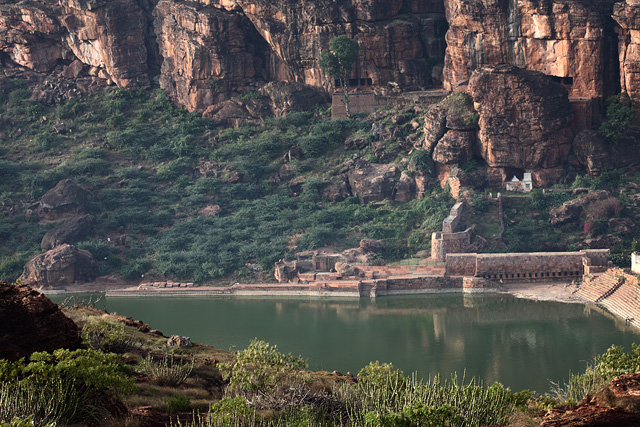
Cave temples and cliffs of Badami
This recorded history of Badami is interesting, but the mythology is even more fascinating. On his journey across the Vindhyas, Sage Agastya was invited by demons Vatapi and Ilvala for a meal. The brothers had the habit of calling guests home and kill them in the most innovative possible way. Vatapi would turn into a ram while Ilvala would cook its meat and offer to the guest. Once eaten, Vatapi would come out splitting the stomach of the guest, thus killing him. The story does not say why did they have to choose such circuitous route to achieve their mission, but it sure makes it very interesting.
But when it comes to legends, sages are always smarter than demons. Agastya knew the whole plan and digested Vatapi before he could come out, putting an end to the evils of the pair. Today, the cliffs around the Agastya Lake in Badami are believed to be the bodies of mighty demons who were defeated by the sage.
The legend would have brought some aura to the town, but it is the remains of history that attracted me here. Temples carved halfway up a cliff are the hallmark of Badami. Built by Chalukya Kings over a period of two centuries, they are among the best surviving structures of early Indian Architecture.
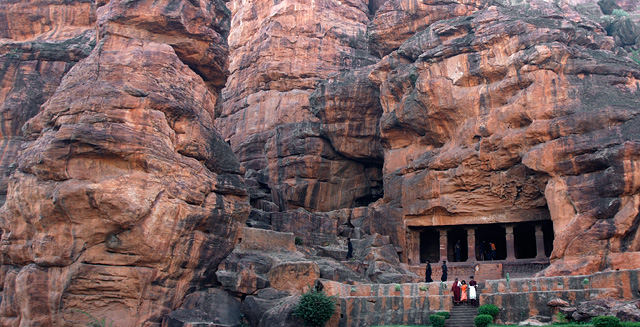
First of the four rock cut temples of Badami
There are four cave temples in Badami with three dedicated to Vedic Gods, the last one being a Jain Temple. The first three temples have some elaborate sandstone carvings of Hindu Pantheon such as Vamana stepping over Bali, dancing Nataraja, Varaha carrying Bhudevi and Vishnu seated on Vasuki. The Jain temple, smallest of the four has a series of Tirthankaras carved along the walls.
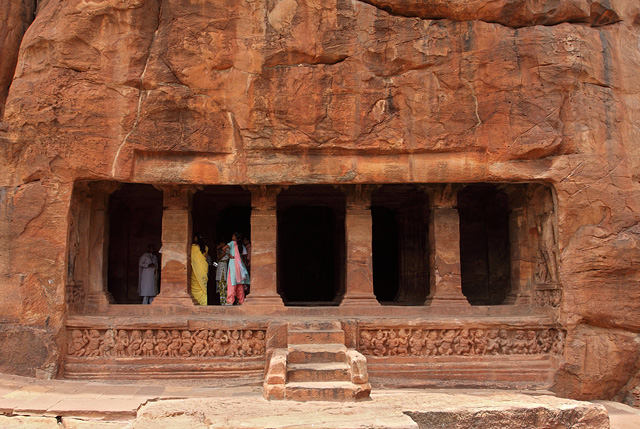
The rock cut temples
Chandru, my ASI certified guide at Badami, was knowledgeable and articulate. He stood in dance positions and held his hands in mudras when he described how the 18-handed statue of Nataraja can form 81 mudras in Bharatanatya by choosing any one of the left hands in combination with any of the right hands. We moved through caves as Chandru described the iconography and architecture, but my questions to him were mostly related to history.
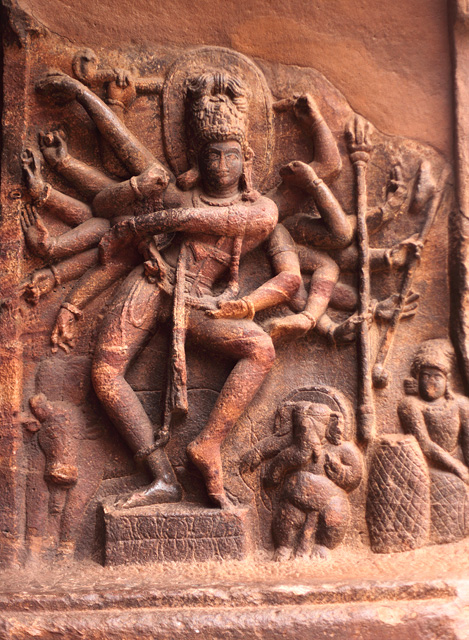
Nataraja relief in the first rock cut temple at Badami
The inscriptions in Badami and surrounding areas are a key to rediscovering most of the Chalukyan history. An inscription carved somewhere high up the rocks on the cliff opposite to the caves describes the times of the first Chalukyan Kings. Another inscription by Pallava King Narasimhavarman I informs of the brief occupation of Badami by Pallavas. A detailed inscription on a pillar at nearby Mahakoota Village, carved in the time of king Mangalesha, provides much needed information about the lineage of Chalukyas and the spread of their kingdom. An inscription in Aihole Village describe the victory of Pulikeshi II over Harshavardhana and another one gives vague clues about the existence and time period of renowned poet Kalidasa.
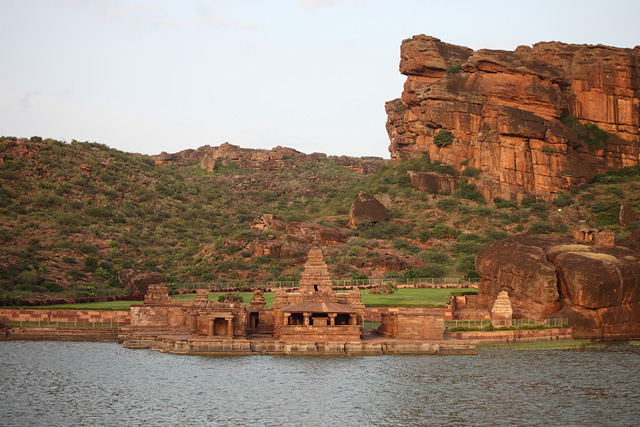
The grand setup of Bhoothanatha Temple, Badami
From my vantage point at these caves up in the hill, I could see the Bhoothanatha Temple at the edge of Agastya Lake. Unlike the cave temples that are full of visitors, the temple premises were empty, save for occasional drifting visitors. The Bhoothanatha Temple is in a grand setup, surrounded by walls of red sandstone rocks on three sides and the waters of the lake lapping up the steps in the front. Sitting in the temple courtyard that evening, I watched the cool breeze ruffling the lake surface as the evening sun disappear behind the town.
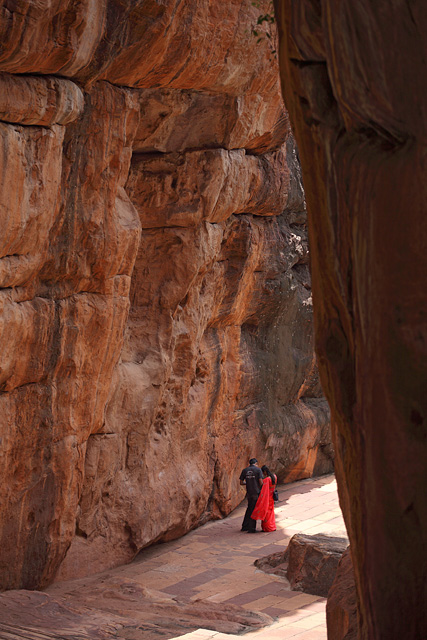
The narrow path through gaps in the sandstone walls of Badami
During my wanderings along the lake shore, I drifted towards the hills opposite to the caves and climbed a short flight of steps that took me up the table-land above. The steps climb through narrow gaps in the rocks that are wide enough at places just to let in a few people at a time. Sunlight peering through the gap and flaring up small sections of the wall make a colourful play of light and shade in these fissures. Up on the hill are a few temples, a few pillars and remains of a fort. Fortification of the hill must have been an easy task, as it mostly involved building walls to restrict entry through the cracks in the rock.
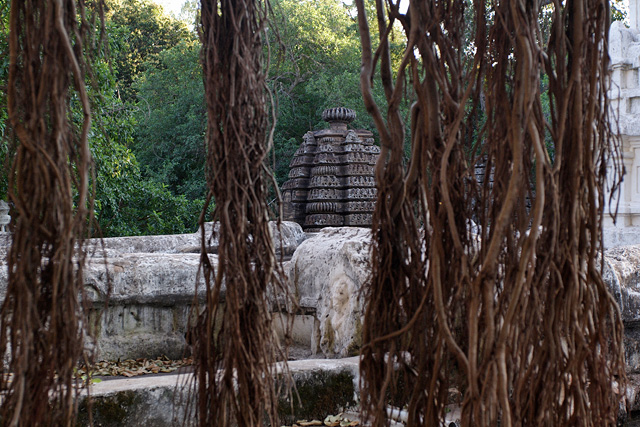
The leafy environs of Mahakuta near Badami
The area around Badami is rich in heritage and strewn with temples that belong to Chalukya era. Excursions from Badami took me first to Mahakoota, a small village dominated by a Chalukyan temple dedicated to Mahakuteshwara. Mahakoota appears like a green island in an ocean of parched land surrounding it. Next to the temple is a sacred grove with thick greenery that creates a cooler local climate that contrasts the scorching weather in the region. The courtyard of the temple is under the shade of large ficus trees. Roots hanging from the trees, temple towers hidden behind the leaves and the silence in the shade bring a calm and soothing feel to the temple surroundings.
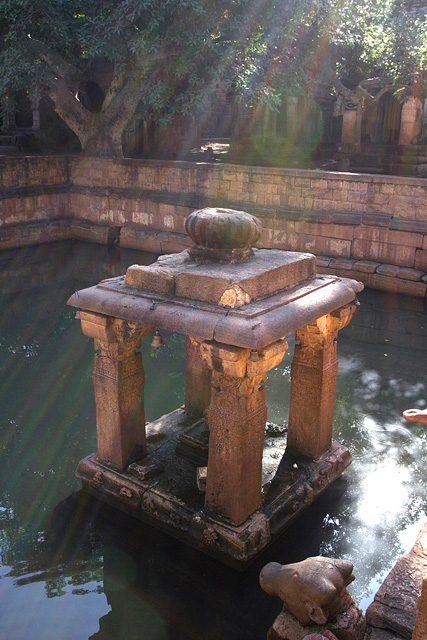
A mantapa at Mahakuta, near Badami
Not far from Mahakuta is Pattadakal, a UNESCO World Heritage Site. The temples here are made of beautiful red sandstone and the carvings have been fading over the years on the external walls due to effect of sunlight. But the interiors appear better preserved. The temples here are a mix of northern Nagar architecture and the Dravidian style of the south.
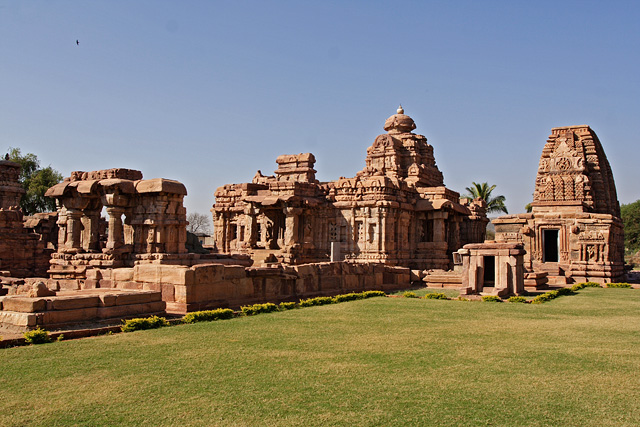
Pattadakal, a UNESCO World Heritage Site near Badami
Further ahead of Pattadakal is Aihole, a village littered with ancient structures that refuse to confirm to any specific style of temple building. With students of those days arriving here from every corner to learn and master the art of carving in stone, historians have often called Aihole as the ‘cradle of Indian architecture.’
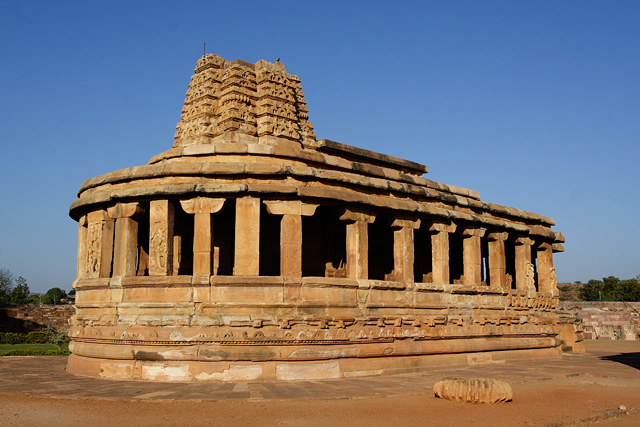
Durgi Gudi, at Aihole near Badami
The first thing that attracts the visitor in Aihole is the well maintained main enclosure of temples in the centre of the village. Taking a tour of the large Lad Khan Temple and well known Durgi Gudi that has parallels with parliament building in its façade, I heard my guide talk about a number of smaller temples spread around the village. Aided by his guidance, I went in search of these ancient structures that seemed to be visited by very few people.
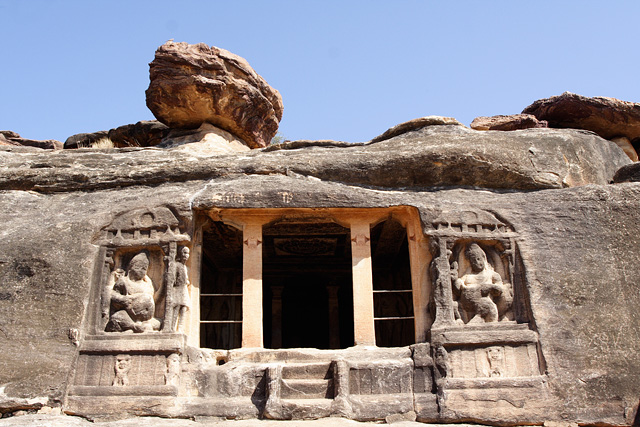
Ravanphadi, a rock cut temple at Aihole near Badami
Among the oldest of these temples is Ravan Phadi, dating back to later half of sixth century. It is a small rock-cut room with a linga in the centre and beautiful carvings on the inner side walls. To the west of Ravanphadi is Huchimalli Temple built in a more formal nagara style of architecture. The temple stands alone in an enclosure far away from other monuments, with its shrine visible from a distance. Seen from anywhere in Aihole is the Meguti Temple located at the top of a hill. Standing next to Meguti Temple, I can see the entire village dotted with ancient temples in all directions and River Malaprabha flowing at the edge of the hamlet.
My visits to Aihole, Badami and its neighbouring heavens of ancient architecture was fuelled by seeing beautiful images of Badami with foaming waters rushing down from its cliffs, as presented in tourist brochures. They were perhaps photographed during the peak monsoon months, but the time when I was there was marked with dry spells. All that I could see was the stains of algae at places where the waterfalls would come alive during the rains. However, the heritage sites in Badami and Pattadakal, the architectural experimentations of Aihole and the calm environs of Mahakoota more than made up for the missing waterfalls. But the appeal of waterfalls now gives me an excuse to plan another tour. As I write this, the monsoons have arrived in most parts of Karnataka and the met department is assuring of good rains for the next few months. It is perhaps time to plan another visit.
 Here is announcing our next photography tour, this time to the rainforests of Agumbe to see and capture special creature that miss the attention of many photographers. Besides Darter Photography Expert, we will also be accompanied by well-known herpetologist, Gowri Shankar who has been a conservation officer at Agumbe Rain Forest Research Station.
Here is announcing our next photography tour, this time to the rainforests of Agumbe to see and capture special creature that miss the attention of many photographers. Besides Darter Photography Expert, we will also be accompanied by well-known herpetologist, Gowri Shankar who has been a conservation officer at Agumbe Rain Forest Research Station.
Photography Tour to Rainforests of Agumbe
Dates – June 24, 25 and 26, 2011
This monsoon, Darter Photography is taking you to the pristine rainforests of the Western Ghats – Agumbe. Experience the place which gets the highest rainfall in South India, get up-close with diverse endemic species of the region and interact with researchers studying these forests. And possibly see and photograph the king of these forests, the aptly named King Cobra.
Tour Details
The rainforests of Agumbe come alive in the peak monsoons. The sound of water droplets falling from high up in the canopy to puddles on the ground, the croaks of frogs as they look for mates, and the multitude of insects buzzing form a natural orchestra that quickly becomes addictive. Little streams flow through the forest, tumbling down as beautiful waterfalls in many places. Fungi of all shapes, sizes and colors are everywhere. Snakes, in their myriad colours and sizes, eagerly wait and lookout for prey. Praying Mantises blend into their environments, perfectly camouflaging themselves…
See full details of the tour here.
This article was first published in ‘Jungle Tales’ a book released by Jungle Lodges and Resort to celebrate 25 years in operation. I made a visit to Bandipur National Park and chronicled my experiences from the tour for the book.
From May 20th to 22nd, Darter Photography (a photography tours venture from pro-photographers Shreeram and me) is travelling to Bandipur. The photography tour to Bandipur involves jeep safaris in the park every morning and evening, where our photographer will work closely with each of the participants and help them make good images of the park’s wildlife. Go here to see more details about the tour and to register.
The lone tusker stopped feeding for a moment and looked at our jeep warily. He appeared immature and lacked the confidence to roam recluse in the forest. His dark hide camouflaged well with the thick undergrowth, but our sharp-eyed driver had spotted the pair of bright tusks through the swaying leaves. The pachyderm looked up through the shrubs cautiously and assessed our intentions in invading his territory. After a brief pause, he decided to beat a quick retreat into the jungle.
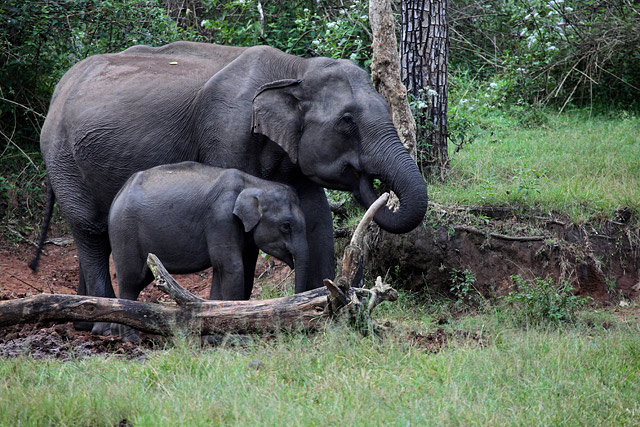
The meeting with this anxious pachyderm ended up in a game of hide and seek. He hastily moved away, but could not resist pausing and turning back to check if we followed him. We infact did. As we drove closer to take a good look at his shining tusks, he retreated further until curiosity stopped him again. We repeated this for a while until he grew bored of us, trumpeted a good-bye and swiftly disappeared in the undergrowth. As he went out of sight, the silence in our jeep was broken by a series of exclamations by the occupants. It was our first wildlife sighting of the day.
The next tryst with elephants happened minutes later, this time less entertaining but much more thrilling. It was a small family lead by a tall and sturdy matriarch who kept a careful watch at a baby in the pack. On seeing us, the matriarch raised her trunk and trumpeted threateningly, sending a message that we were not welcome. She moved forward and violently pushed a nearby tree, which crackled and gave away in seconds. The tree trunk broke and was on the ground even before we knew what happened. The matriarch’s intentions were clear. We fled immediately.
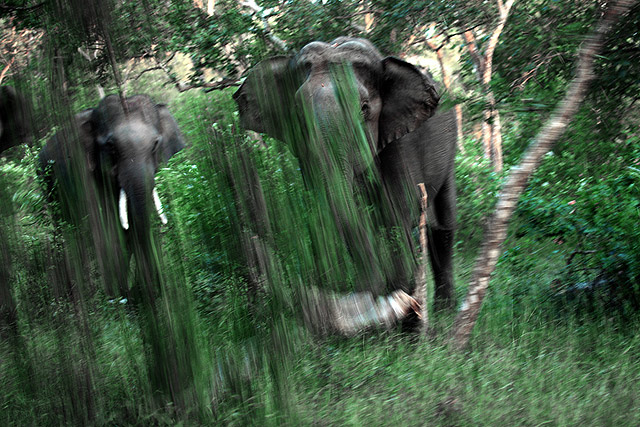
The tryst with these large mammals continued during my stay at Bandipur Safari Lodge. Next evening, we accidentally crossed path with an elephant which was crossing the road to join its herd. It was too close to us for comfort, standing just a few meters from the jeep’s bonnet. My heart stopped for a moment as the elephant paused and contemplated its next move. Unhappy at the intrusion, she nearly charged at us and before turning around and disappearing in the bushes. What seemed to be a grave danger had subsided in an instant.
Not every encounter however, was an uneasy one. In another occasion, we saw a small herd foraging calmly next to a pond, completely ignoring our presence. They nonchalantly plucked blades of grass and rid them of the mud by pounding into the ground before feeding. They flapped their ears and occasionally scooped a pile of mud and splashed it on their backs. A small baby moved playfully between the legs of the matriarch. For them, life in the forest was mostly normal, but for a few uneasy brushes with the troublesome humans.
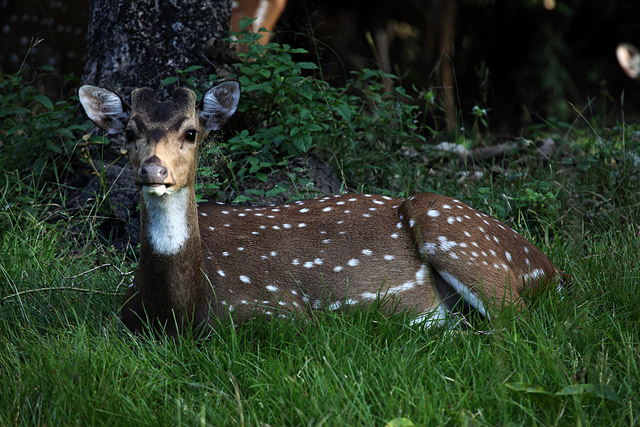
Encounters of forest life in Bandipur were not just limited to boundary of the national park. Back at the Safari Lodge, the fig trees attracted birds in large numbers. “This place will be teeming with Asian Koels and Grey Hornbills,” said the naturalist Nataraj, “wait till the figs ripen.” The figs were still green, but the grassy surroundings and flowering vines still attracted the smaller birds. Magpie robins whistled continuously as they searched for insects on the ground. Purple sunbirds with their shining feathers fluttered from flower to flower and sucked the sweet nectar. Shrikes meditated on the dry branches in the open ground next to the lodge and kept an eye for prey. The edge of the park was as alive as the forest itself.
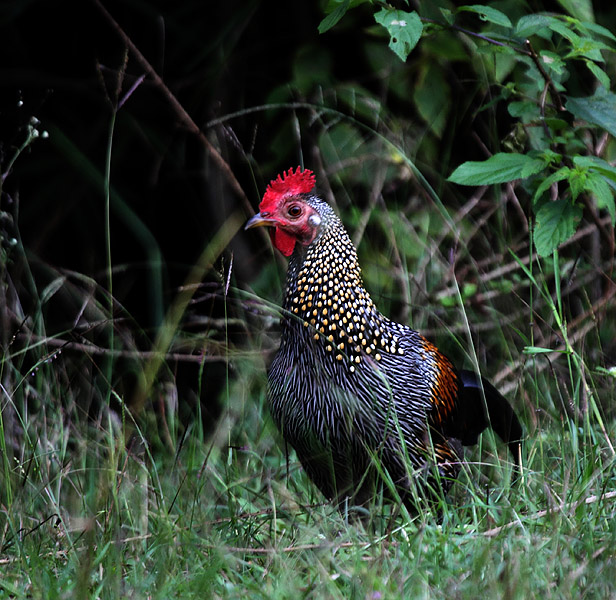
I was busy chasing the birds at the lodge when good news came from the forest. One of the drivers had spotted a leopard kill on a tree in the woods. We drove there next morning in the hope of seeing the elusive big cat guarding its kill. However, like they say grass is greener on the other side, sightings in the jungle are always better from the other jeep! A small group who left the lodge before us got a chance to see the leopard to their heart’s content, but it had disappeared into the thicket just before we arrived. The kill, a sambar deer, was still hanging on a branch a good hundred feet above the ground. I was amazed, imagining the strength of the beast that could lift the carcass weighing more than a hundred kilos up the tree. Later that day, there was news of sightings of leopards, a tiger and a group of wild dogs. I missed seeing them myself, but it was heartening to know that the forest is teeming with these endangered mammals.
I did not see the action that day, but our driver Pradeep entertained me with his tales from the jungle. Only a week earlier, he had spent more than an hour watching a tiger from just a few meters away as it lazily walked past the vehicle and settled comfortably next to a puddle. In another incident, he had observed a bunch of wild dogs pinning down a spotted deer. It must be an exciting life being behind the wheels in this forest.
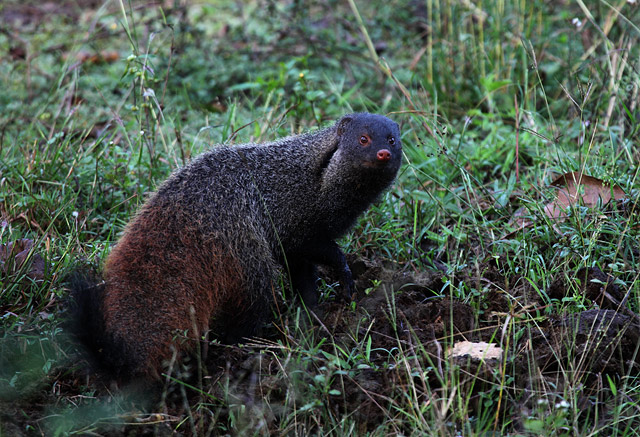
Even while I missed the leopards and tigers, the morning safari was a delightful hour of sighting many birds and smaller animals. I saw several Grey Jungles Fowls flaunting their bright red and grey feathers. Peafowls gracefully walked next to our jeep, as though oblivious to our presence. Malabar parakeets squeaked as they landed on dry branches. A pair of stripe-necked mongoose fought playfully by falling over each other and darted into the bushes on our approach. Alert sambar deer gazed at us as we drove past them. Spotted deer in small groups grazed peacefully next to our tracks. Together, they made up for the disappointment of having missed the leopard.
Wanderings in the woods gave me a closer look at the life in the forest. Back from the unsuccessful search for the leopard, I headed out to Gopalawamy Betta, the highest peak in the park that gave me a different perspective – a bird’s eye view of the expanse.
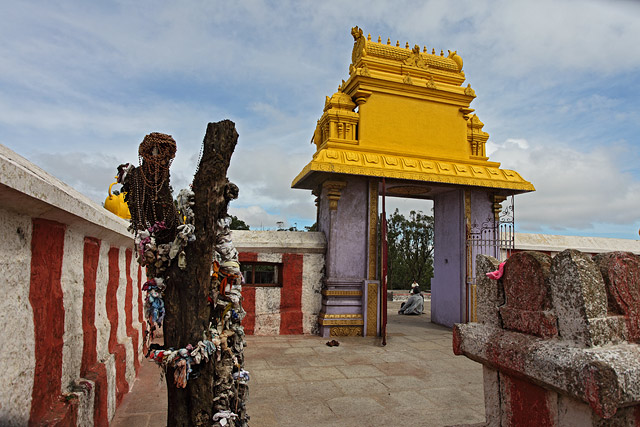
At the peak is a small temple dating back to 14th century built by a Chola King and later patronized by the Maharaja of Mysore. Standing on the temple courtyard, I could see the never ending green canopy of the national park and adjoining forests of Nagarahole and Wayanad. The large reservoir of Kabini—a favourite haunt of elephants during dry summer days—glittered near the horizon. Everywhere else was thick greenery covering the undulating landscape of the park. Lofty mountains of Nilgiri Ranges rose high at the southern edge.
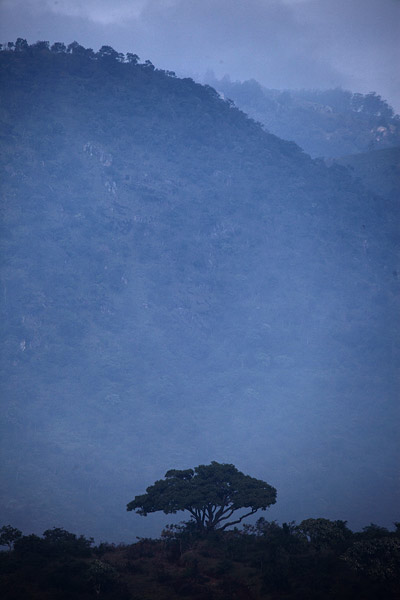
Next morning, Nataraj took me for a short trek in the periphery of the forest. Walking past houses and fenced fields, we sighted yellow browed bulbuls, several larks, ashy prinias and bay-backed shrikes. The tall trees closer to the forest housed less common birds like yellow footed green pigeons, hill mynas and rocket tailed drongos.
My tryst with elephants continued even during the trek. Nataraj spotted a few broken branches, trampled grass and fresh dung which indicated the signs of their presence. They had wandered to the edge of the forest in the night and were foraging in the bushes a little ahead on our way. The presence of elephants meant we had to alter our plans of walking up a hillock in the forest. As we made a round about and returned from the trek, my visit to Bandipur had ended the same way it started – in the company of elephants.











 Here is announcing our next photography tour, this time to the rainforests of Agumbe to see and capture special creature that miss the attention of many photographers. Besides Darter Photography Expert, we will also be accompanied by well-known herpetologist, Gowri Shankar who has been a conservation officer at Agumbe Rain Forest Research Station.
Here is announcing our next photography tour, this time to the rainforests of Agumbe to see and capture special creature that miss the attention of many photographers. Besides Darter Photography Expert, we will also be accompanied by well-known herpetologist, Gowri Shankar who has been a conservation officer at Agumbe Rain Forest Research Station.





